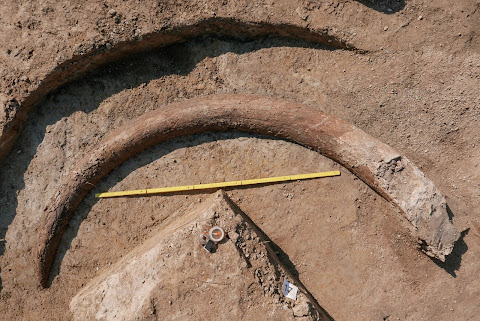Bavarian authorities announced that archaeologists had found an unusually large, ice-age mammoth tusk during an excavation. The tusk, measuring nearly 2.5 meters (8 feet) in length, was found southeast of the city of Regensburg as archaeologists were looking for remains of a 15th-century town, Bavaria's Regional Office for Cultural and Historic Preservation said in a press release.
 |
| The mammoth tusk excavated in Riekofen [Credit: Bavarian State Office for the Preservation of Monuments] |
"With its 2.45-meter length, including tip tooth, this tusk is an extraordinarily complete find. An absolute stroke of luck," said Gertrud Rössner, the head of the state's geological and palaeontological mammal collection.
Mammoths lived in Bavaria, Germany's most southwest state, until 20,000 years ago. It is not usual for mammoth remains to be unearthed in Bavaria, but finding such a long and complete tusk is extremely rare, the office said.
 |
| Dr. Christoph Steinmann from the Bavarian State Office for Preservation of historical monuments excavates mammoth tusk [Credit: ArcTron Co.] |
Bavarian archaeologist Christoph Steinmann theorized that both bones had been immersed in water a long time ago. This would explain why the outer layers of the tooth remained intact, even though the inside substance had cracked over time. Had the outside been exposed to the air, it would have crumbled immediately, Steinmann added.
 |
| Dr. Steinmann excavates mammoth bone [Credit: ArcTron Co.] |
* This article was originally published here






Комментариев нет:
Отправить комментарий